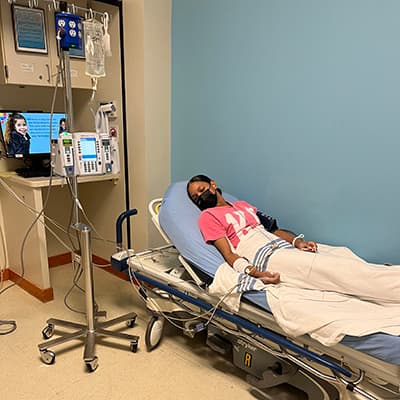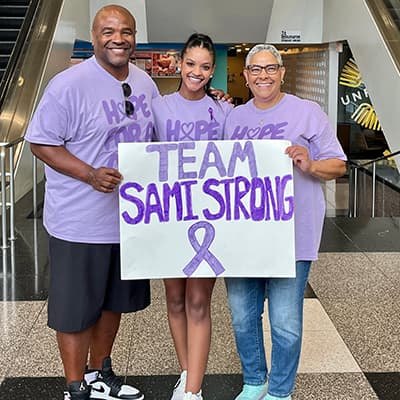Superior Mesenteric Artery Syndrome: Sami’s story
Meet Sami

Sami’s megawatt smile is powered by hard-earned positivity. The 18-year-old is taking a gap year, working as a reading paraprofessional at an Overland Park elementary school and visiting colleges with strong human and family developmental science programs. Inspired by her own experiences at Children’s Mercy, Sami wants to be a hospital child life specialist.
When she was 13, Sami started getting bad headaches and flu-like symptoms. She went to the Children’s Mercy Emergency Room but tested negative for viruses. Her stomach issues got so severe she couldn’t tolerate any food.
“During [the fall of 2020], I was in the ER almost every two weeks,” said Sami, who was losing an extreme amount of weight. “It got life-threatening; I could barely walk.”
That January, she was admitted to Children’s Mercy and diagnosed with Superior Mesenteric Artery syndrome (SMAS).
2 battles with SMAS
“The duodenum, the first portion of the small intestine, lies right over the superior mesenteric artery,” explained Craig Friesen, MD, Associate Division Director, Research, Division of Gastroenterology, Hepatology & Nutrition. “Normally, there’s a fat pad that holds the duodenum off the artery, so things can flow. If you lose weight, you lose that fat pad, and then that bowel folds over that artery and obstructs your small intestine.”
SMAS is diagnosed in part by measuring the angle between the abdominal aorta and the superior mesenteric artery. When it’s under 25 degrees, the duodenum is compressed. SMAS symptoms can often be confused or obscured by underlying GI issues, and some patients will go a long time before getting a diagnosis.
“It takes a lot of people years to find this, but [Children’s Mercy] found it immediately,” said Sami.
SMAS is usually a consequence of another GI condition, not a solo diagnosis. Treatment is twofold: Help the patients gain weight, so the fat pad comes back and lifts the duodenum off the artery. And then figure out what caused their weight loss and treat the underlying problem.
In Sami’s case, significant inflammation caused her initial weight loss, led to SMAS and then made it more difficult to recover. The small intestine obstruction can reduce blood flow to the area and cause mechanical problems that last — even if the SMAS angle improves with weight gain.

Sami had a nasojejunal (NJ) feeding tube to get nutrition past the obstruction and began medication for the inflammation. She was homebound for her eighth-grade year as her team worked to find her some relief.
“Her inflammation really persisted,” said Dr. Friesen. “Despite her weight being where we wanted it to be, all the imaging continued to show hang ups in that area.”
Fortunately, her SMAS went into remission the fall of 2021, and Sami was able to attend her freshman and sophomore years of high school.
“All of a sudden, in October 2023, I relapsed again,” said Sami. “It started with the same symptoms: a headache and then stomach issues.” A scan showed the SMAS was back.
“She did well for a period of time, but then that inflammation flared back up,” said Dr. Friesen. “It became much more difficult.”
“Children’s Mercy became my second home,” said Sami. “I was always there. I knew all of the staff.”
Sami started with an NJ tube, but by the spring of 2024, she needed a peripherally inserted central catheter (PICC) line for intravenous nutrition.
Finding “little positives in everything”

Sami got her first PICC line on her 17th birthday — not exactly the party a teenager hopes for. But the Child Life team made the day a splash. Overnight, they snuck into her room to deliver balloons and cards to surprise her. “I woke up to my room decorated,” said Sami. “It was so sweet.”
She was so touched by the gesture, Sami created Birthday Brightness, an organization to benefit Children’s Mercy patients who are staying in the hospital during their birthdays. She raises money to buy gifts and supplies, so other patients can feel celebrated, too. She’s excited to deliver her first round of birthday goodies soon.
Sami’s second battle with SMAS was long and hard: She wasn’t able to eat or drink anything for 2 years and was mostly homebound for her junior and senior years. But she’s quick to point out the good times, like getting to go to her senior prom. “I got to be prom queen, which is awesome, because I didn’t even run,” laughed Sami.
“Our family is always finding the little positives in everything,” said Sami. “Like, ‘I have to spend my birthday in the hospital, but, oh, my goodness, I’m surrounded by so much love right now.’”
“Sami was amazingly resilient,” said Dr. Friesen. “She also had parents who were incredibly supportive, focused on her getting better and didn't define her as an ill person. Those things have huge effects on outcomes.”
That resilience empowered her team to keep trying different approaches to ease Sami’s pain, including a celiac nerve block, nerve stimulation and a laparoscopic duodenal mobilization surgery in June of 2024.
“The small intestine has a ligament that fixes it to the area of the obstruction,” explained Dr. Freisen. “The surgeons mobilize it so it’s free floating and off the artery. Sami's X-rays weren’t completely normal afterward, but I do think it allowed things to flow freely.”
They continued to treat the inflammation and get Sami the nutrition she needed. In the early summer of 2025, Sami went into remission again. She’s home now, with her mom, Rana, and dad, Jerome, and adjusting to a non-hospital life.
“I’m slowly getting back to eating,” said Sami. “It took me time to work up an appetite, but it’s much better now. I’m working on it.” The first two foods she asked for? A chicken Caesar salad and chocolate chip cookie dough ice cream!
She’s started exercising again and loves spending time with her family and dog, going on long walks, watching movies and taking family trips to see her older siblings. She’s looking forward to applying to colleges — she was too sick to think about universities before.
A hopeful resolution

“I would call it resolved,” said Dr. Friesen, of Sami’s SMAS. “I don’t expect the obstruction is going to come back, but she is at risk for the underlying inflammation coming back.”
Infection can trigger inflammation, so Sami is vigilant with handwashing and hand sanitizing — especially while she’s working with elementary schoolers.
“She may be the most resilient person I’ve taken care of in 40 years,” said Dr. Friesen.
And Sami praises Dr. Friesen’s determination as well: “Dr. Freisen has treated me ever since I was diagnosed. He tried every single medication, every single procedure. He’s one of my favorite people.”
Dr. Friesen encourages families to take GI symptoms like Sami’s seriously and get help from specialists as soon as possible. “If they are losing weight, that’s a red flag to go get it taken care of,” said Dr. Friesen, who advocates for aggressive, persistent attention to chronic abdominal pain.
Sami’s advice for patients going through similar struggles is to stay positive, even (especially) when it’s hard.
“I’m really big on keeping hope,” she said. “I know it’s easier said than done. It’s really hard when you’re in the moment; it’s hard to see that light. But I totally live by this quote [from R.M. Drake] that I had up when I was in treatment. It says:
‘Never lose hope.
There are 1,000 beautiful things waiting for you.
Sunshine comes to all who feel rain.’
“Now look at me: I get to have a full-time job, and I never would have seen that if I didn’t keep hope!”